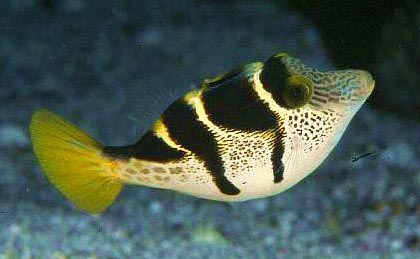Drugs developed from biological toxins
are new additions to the therapeutic armamentarium for pain
control. One example is purified Botulinum toxin Type A (Botox),
which binds to the presynaptic nerve terminal to prevent the
release of acetylcholine and thereby prevents neurotransmission.
This extremely potent bacterial toxin is currently being used
for the treatment of myofascial pain, various spasmodic neuromuscular
disorders, and for cosmetic procedures. Another example is Ziconotide,
an N-type calcium channel blocker, which could soon be approved
by the FDA for intrathecal treatment of neuropathic pain through
the SynchroMed implantable drug infusion system. This new drug
is a conopeptide that was developed through research on marine
cone shell conotoxin.
|
|
|
Mappa
Pufferfish
Photograph
by Carlos Villoch
|
Solander's
Sharpnose Puffer
(Canthigaster solandri)
Photograph
by Carlos Villoch
|
Perhaps the most fascinating
new potential drug is derived from highly purified blowfish
toxin (Tetrodotoxin), a complex non-protein toxin extracted
from the blowfish. Many colorful species of this spiny, balloon-like
"puffer fish" are known to exist and they vary widely in the
amount of toxin present. The blowfish is known as "fugu" in
Japanese, and the word is believed to be derived from "fukube",
meaning a round-bellied type of vase. The ancient Chinese and
Japanese were aware of the fact that the fugu poison was mostly
concentrated in the fish's liver, testes, ovaries, and eggs.
Symptoms of TTX poisoning can occur within fifteen minutes to
several hours after ingestion and start with paresthesias, floating
feelings, nausea, vomiting, epigastric pain, and hypotension.
Death can occur in 4-6 hours through respiratory depression
as a result of paralysis of the respiratory nerves and musculature.
Today, fugu is considered a great delicacy in Japan where it
is eaten for its unique flavor accompanied by perioral and lingual
paresthesias. Specially licensed chefs are trained to prepare
the fish for consumption and most of the 100 annual poisonings
are from ingestion by fisherman or through obtaining the blowfish
from fishmarkets. An old Asian proverb gives insight to its
special allure: "The man that eats fugu is stupid; the man that
does not eat fugu is also stupid."
TTX is a prototypical sodium
channel blocker that has been widely used as a neuropharmacologic
probe. Sodium channel blockers act to block the diffusion of
sodium through the sodium channel so as to prevent depolarization
and propagation of action potentials in nerve cells. It has
been recognized that many anticonvulsants beneficial for neuropathic
pain as well as amide anesthetics given by injection to produce
nerve block are also sodium channel blockers.

Black-saddled
Sharpnose Puffer
(Canthigaster valentini)
Photograph
by Carlos Villoch
Japanese researchers were
the first to experiment with crude blowfish extract for pain
control. TTX had been tested in animal models for the experimental
treatment of opioid withdrawal. This led to the study of TTX
as a systemic analgesic and long-acting anesthetic. Potentially
the most ground-breaking studies involve the experimental use
of TTX in humans as a powerful non-addictive systemic analgesic.
In addition, large numbers of heroin addicts suffering from
typical withdrawal pain symptoms have undergone treatment with
purified TTX. Research done in China in the past four years
at Beijing Medical University and other major institutions has
resulted in a highly purified TTX which appears to be more potent
with fewer side effects as compared to commercially-available
TTX used in neurophysiology research. International Wex Technology
(IWT), a publicly traded Canadian bio-pharmaceutical company
that has licensed and patented this technology for clinical
applications, manufactures this compound under the name Tetrodin™.
Tetrodin™ has been tested
in Beijing, China for chronic malignant pain in open-label studies.
Patients were suffering from metastatic cancer from various
primaries (liver, stomach, and rectal), and complained of high
levels of pain despite opioid treatment such as round-the-clock
meperidine injections. With TetrodinTM, pain relief was noted
at 5-30 minutes after the first injection. Patients were treated
for only three days, and reported dramatic improvement and virtually
no pain, with quality-of-life measurements assessed to be at
much improved levels. These patients reported continued pain
relief without known administration of additional analgesic
agents at follow-up periods of 2-3 weeks. Phase II double blind
studies will help confirm the significance of these dramatic
findings.
IWT is currently completing
North American Phase I safety studies for Tetrodin™. Significant
side effects have included perioral/lingual paresthesia in all
subjects, as well as mild nausea in some patients, and have
essentially replicated the Chinese data. Phase II trials will
test the drug for malignant and neuropathic pain, and also seek
to confirm the Chinese experience in using the drug to treat
withdrawal symptoms in opioid-dependent patients. Pre-clinical
testing for the use of Tetrodin™ as a long-acting anesthetic
is currently in progress.
TTX could represent a unique
alternative to currently available analgesics without the risk
of addiction. It appears to be long-acting and its mechanism
of action may prove useful in managing both somatic/visceral
as well as neuropathic pain states.
Close relatives of
Pufferfish:
|
|
|
Boxfish
Photograph
by Carlos Villoch
|
Spotted
Porcupinefish
(Diodon
hystrix)
Photograph
by Carlos Villoch
|
References
1. Kao CY, Tetrodotoxin,
Saxitoxin and their significance in the study of excitation
phenomena. Pharmacologic Reviews, Vol 18, No 2, 1966
2. Shuping S, Qingbin D,
Clinical Study Report of Tetrodin™ Treating Cancer Pain, Data
on File, Nanning Maple Leaf Pharmaceutical Co.
3. Light WH, "Eye of Newt,
Skin of Toad,Bile of Pufferfish." California Wild, Summer 1998
4. Hunter JC, Loughhead
D, Voltage-gated sodium channel blockers for the treatment of
chronic pain, Current Opinions in CPNS Investigational Drugs
1999 1(1) :72-81
5. Zheng JW, Lu SN, Preliminary
Test on the Analgesia Pharmacodynamics of TTX, National Institute
on Drug Dependence, Beijing Medical University (1996)
For
more information, please contact the authors:
Howard
Cohen, MD of Dallas, tel: (214) 826-3200, email: saratoga@jump.net
Byron
Law-Yone, MD of Dallas, tel: (972) 243-3343, email: headoc01@aol.com